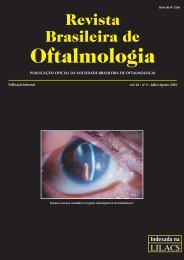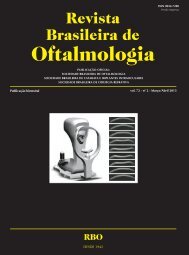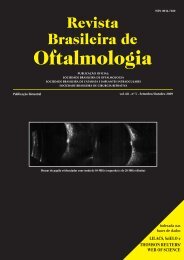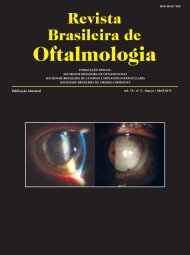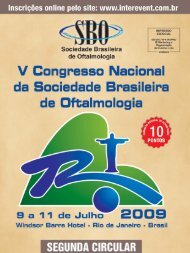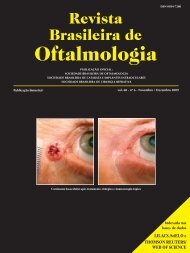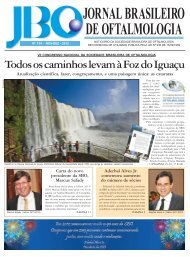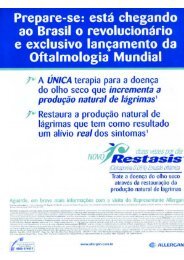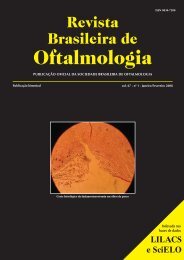Perfil do Setor <strong>de</strong> Lente <strong>de</strong> Contato da Santa Casa <strong>de</strong> Misericórdia do Rio <strong>de</strong> Janeiro81Entre ao pacientes présbitas, 30,47% foram adaptadoscom o recurso da monovisão simples, no qual ajusta-seum olho para visão <strong>de</strong> perto e o outro para a visãoa distância, sendo uma alternativa simples e econômicapara correção da presbiopia. Este sistema continua sendoum dos métodos mais bem sucedidos para se corrigira presbiopia 35 anos após ter sido proposto. (5)Do total <strong>de</strong> casos, 64,51% das adaptações foicom lentes rígidas e 35,49% com lentes gelatinosas.Dentre as lentes gelatinosas, 69,05% dos casos foramadaptados com lentes convencionais esféricas <strong>de</strong> usodiário (baixa hidratação), e apenas 7,14% dos casos comlentes convencionais esféricas <strong>de</strong> uso prolongado e 5,55%dos casos com lentes convencionais tóricas <strong>de</strong> uso diário.No estudo <strong>de</strong> Meyer et al quanto ao material utilizado,em 43,7% dos casos prescreveu-se lentes rígidas gáspermeáveis,46% gelatinosas, PMMA em 1,5%, tóricas(hidrofílicas) em 0,5%, e tóricas rígidas gás-permeáveisem 1,3%.Em 78% dos casos <strong>de</strong> astigmatismo foram usadaslentes rígidas, e somente 3% dos pacientes usaramlentes hidrofílicas <strong>de</strong> uso prolongado (2)(a gran<strong>de</strong> maioriaem crianças afácicas).Apesar das lentes <strong>de</strong> contato gelatinosas sereminicialmente mais confortáveis do que as rígidas, asvantagens das lentes rígidas gás-permeáveis são: qualida<strong>de</strong><strong>de</strong> visão (po<strong>de</strong>ndo até mesmo ser melhor doque com os óculos <strong>de</strong>vido à redução das aberraçõesópticas da córnea), saú<strong>de</strong> ocular, facilida<strong>de</strong> <strong>de</strong> cuidados,durabilida<strong>de</strong>, conforto a longo termo, e à possibilida<strong>de</strong><strong>de</strong> redução na progressão da miopia em indivíduosjovens. Para melhorar o conforto inicial, po<strong>de</strong>mosoptar por lentes com um maior diâmetro, umaborda lisa e polida, curvas periféricas amplas e umaadaptação com a lente bem centrada na córnea (aoinvés <strong>de</strong> <strong>de</strong>scentrada inferiormente). No primeiro teste<strong>de</strong> adaptação po<strong>de</strong>mos utilizar colírio anestésicopara romper a barreira psicológica <strong>de</strong> sentir a lenteem pacientes apreensivos. A forma como o adaptadorencara as lentes rígidas po<strong>de</strong> influenciar a sua apresentação,tendo forte influência nos pacientes.Devido ao seu baixo custo, fácil manutenção emenor probabilida<strong>de</strong> <strong>de</strong> causar infecções, as lentes rígidascontinuam sendo uma ótima opção para a correçãodo astigmatismo <strong>de</strong> origem corneana. Foi <strong>de</strong>monstradoque em comparação com as lentes rígidas gás-permeáveis,o risco <strong>de</strong> uma lente hidrofílica <strong>de</strong> uso prolongadocausar ceratite infecciosa é 21 vezes maior, e <strong>de</strong> umalente hidrofílica <strong>de</strong> uso diário é 4 vezes maior constatandoum aumento do risco <strong>de</strong> 1,3 vezes para o uso <strong>de</strong> lentesrígidas <strong>de</strong> polimetilmetacrilato, em comparação com ouso <strong>de</strong> lentes rígidas gás-permeáveis. (6) Em nosso estudo,<strong>de</strong>mos preferência às lentes rígidas gás-permeáveis <strong>de</strong>baixo DK <strong>de</strong>vido à maior dureza, durabilida<strong>de</strong> e resistênciado material à formação <strong>de</strong> <strong>de</strong>pósitos, satisfazendoplenamente para o uso diário.Segundo Schein et al há um risco 10 a 15 vezesmaior <strong>de</strong> ceratite ulcerativa em indivíduos que dormemcom lentes <strong>de</strong> contato gelatinosas <strong>de</strong> uso prolongado,do que em indivíduos que fazem uso <strong>de</strong> lentes <strong>de</strong>contato gelatinosas <strong>de</strong> uso diário, em regime estritamentediário. O hábito <strong>de</strong> dormir com as lentes foi consi<strong>de</strong>radocomo o principal fator <strong>de</strong> risco para a doença.(7)Esses autores também verificaram que 11% dos usuários<strong>de</strong> lentes <strong>de</strong> uso diário dormiam com as lentes eque 38% dos usuários <strong>de</strong> lentes <strong>de</strong> uso prolongado faziamapenas uso diário das mesmas. Assim, quando comparadasapenas pelo tipo <strong>de</strong> uso, as lentes <strong>de</strong> uso prolongadoapresentaram risco 4 vezes maior que as <strong>de</strong>uso diário. Devido a estes fatos, em relação às lenteshidrofílicas, preferimos as <strong>de</strong> baixa hidratação (uso diário)<strong>de</strong>vido a maior segurança em relação às lentes<strong>de</strong> alta hidratação (uso prolongado). Optamos pelaslentes hidrofílicas <strong>de</strong> alta hidratação apenas nos casos<strong>de</strong> alta hipermetropia (acima <strong>de</strong> 6 dioptrias) <strong>de</strong>vido amaior espessura da lente, o que também foi observadono estudo <strong>de</strong> Meyer et al (2) .Também foi relatado que usuários <strong>de</strong> lentes <strong>de</strong>contato <strong>de</strong>scartáveis têm um risco aproximadamente 14vezes maior <strong>de</strong> ceratite ulcerativa em comparação comusuários <strong>de</strong> lentes gelatinosas convencionais <strong>de</strong> uso diárioe 7 vezes maior do que em usuários <strong>de</strong> lentes gelatinosasconvencionais <strong>de</strong> uso prolongado. (8) Quando houvea introdução das lentes <strong>de</strong>scartáveis no mercado, esperava-seque estas fossem reduzir o risco <strong>de</strong> complicações.Entretanto, a facilida<strong>de</strong> <strong>de</strong> adaptação e a vendasem controle criaram a falsa sensação <strong>de</strong> segurança total,com a conseqüente <strong>de</strong>spreocupação com os cuidados<strong>de</strong> uso e manutenção. A ênfase na conveniência do usoestendido e <strong>de</strong>scartável acabou gerando a tendência <strong>de</strong>banalização da utilização <strong>de</strong>ssas lentes (9) .Em nosso estudo optamos pela adaptação <strong>de</strong> lentesconvencionais <strong>de</strong>vido à sua maior segurança e vantagemeconômica, pois ao longo <strong>de</strong> um ano as lentes<strong>de</strong>scartáveis tornam-se uma opção bem mais cara <strong>de</strong>vidoa necessida<strong>de</strong> <strong>de</strong> reposição das lentes. Além disso,observamos que a maioria das pessoas não faz uso<strong>de</strong>scartável (<strong>de</strong>scarte das lentes ao retirá-las dos olhos)das lentes <strong>de</strong>scartáveis, mas sim uso na forma <strong>de</strong> trocaplanejada, o que gera a necessida<strong>de</strong> dos mesmos cuidadosutilizados com as lentes convencionais, que por seremmais encorpadas, são mais fáceis <strong>de</strong> manusear, gerandoconforto semelhante.Rev Bras Oftalmol. 2005; 64 (2): 77-82
82Cukierman E, Boldrim TCONCLUSÃOEmbora a indicação estética tenha sido a maisfreqüente, uma fração significativa dos candidatos teveindicado o uso das lentes <strong>de</strong> contato por razões médicas,provavelmente por se tratar <strong>de</strong> um serviço <strong>de</strong> referência.As lentes rígidas apresentaram um papel <strong>de</strong> <strong>de</strong>staquenas adaptações, e <strong>de</strong>ntre as adaptações com lentesgelatinosas houve, na maioria dos casos, preferência parao emprego <strong>de</strong> lentes convencionais <strong>de</strong> uso diário.SUMMARYPurpose: To <strong>de</strong>scribe the statistics of The Sector of ContactLens of Santa Casa da Misericórdia do Rio <strong>de</strong> Janeiro(Prof. Paiva Gonçalves Filho Eyes Service). Methods:Retrospective study of 355 cases of contact lenses fittingbetween September 2000 and August 2003. Results: Thebiggest number of cases occurred among female patients(62,82%) and the most frequent indication was esthetics(48,45%), what was also observed in the following ages:20-39 years old and 40-64 years old. Among the otherages, the most frequent indication was medical (46,48%of the total number), being the most common causesanisometropia (24,51%) and keratoconus (19,72%).Among the cases of keratoconus, 94,29% were fitted withmonocurve spherical rigid lenses and 5,71% with bicurverigid lenses. Among the presbit patients, 30,47% of thecases were adapted with simple monovision resources andthe remaining cases with the prescription of near visionspectacles on the contact lens. From the total number offitted cases, 64,51% were with rigid lens (mainly sphericalof low DK) and 35,49% with soft lens (mainly sphericalconventional of0 daily-wear). Conclusions: Although theesthetic indication has been the most frequent one, anexpressive number of candidates had the indication of theuse of contact lenses due to medical reasons, probablybecause it is a service of reference. The rigid lenses hadan important role in fitting and among the soft lensesthere was a preference for conventional daily-wear.Keywords: Contact lenses/statistical & numericaldata;Adaptation; Retrospective studiesREFERÊNCIAS1. Coral Ghanem C, José NK. Lentes <strong>de</strong> contato na clínicaoftalmológica. Joinville: 1995.2. Meyer GC, Vilela M, Weymar J. Lentes <strong>de</strong> contato: seguimentoem 6 meses <strong>de</strong> 508 novas adaptações. Arq BrasOftalmol. 1991; 54(3): 119-26.3. Kastl PR, Donzis PB, Cole HP 3rd, Rice J, Baldone JA. A 20-year retrospective study of the use of contact lenses inkeratoconus. CLAO J. 1987; 13(2): 102-4.4. Leça RG, Fukushima N, Gonzaga R, Lipener C, Zamboni F,Lewinsky R, Uras R. Estudo clínico da adaptação <strong>de</strong> lentes<strong>de</strong> contato no ceratocone. Arq Bras Oftalmol. 1995; 58(3):149-51.5. Stein HA. The management of presbyopia with contact lenses:a review. CLAO J. 1990; 16(1): 33-8. Review.6. Dart JK, Stapleton F, Minassian D. Contact lenses and otherrisk factors in microbial keratitis. Lancet. 1991; 338(8768):650-3.7. Schein OD, Glynn RJ, Poggio EC, Seddon JM, Kenyon KR.The relative risk of ulcerative keratitis among users of dailywearand exten<strong>de</strong>d-wear soft contact lenses. A case-controlstudy. Microbial Keratitis Study Group.N Engl J Med. 1989;321(12): 773-8.8. Buehler PO, Schein OD, Stamler JF, Verdier DD, Katz J. Theincreased risk of ulcerative keratitis among disposable softcontact lens users. Arch Ophthalmol. 1992; 110(11): 1555-8.9. Maia EM, Pietrovicz J, Maia M, Ramos ARB, Moreira JuniorCA. Adaptação e venda <strong>de</strong> lente <strong>de</strong> contato pelas ópticas <strong>de</strong>Curitiba. Rev Bras Oftalmol. 1999; 58(5): 396-400.ENDEREÇO PARA CORRESPONDÊNCIA:Eduardo CukiermanRua Siqueira Campos, 43 / salas 410 e 411 –Copacabana – Rio <strong>de</strong> Janeiro – RJ – CEP 22031-070Fax: (21) 2549-3394E-mail: eduardomba@terra.com.brRev Bras Oftalmol. 2005; 64 (2): 77-82
- Page 2: RevistaBrasileira deOftalmologiaPUB
- Page 5 and 6: 6897 Comparação da eficácia do B
- Page 7 and 8: 70Anatomia patológica ocular e o e
- Page 9 and 10: 72Schellini SA, Matai O, Shiratori
- Page 11 and 12: 74Schellini SA, Matai O, Shiratori
- Page 13 and 14: 76Schellini SA, Matai O, Shiratori
- Page 15 and 16: 78Cukierman E, Boldrim TINTRODUÇÃ
- Page 17: 80 Cukierman E, Boldrim Tem 1 caso
- Page 21 and 22: 84 Freitas JAH, Freitas MMLH, Freit
- Page 23 and 24: 86Freitas JAH, Freitas MMLH, Freita
- Page 25 and 26: 88 Marback EFMÉTODOSForam estudado
- Page 27 and 28: 90 Marback EFDISCUSSÃONossos resul
- Page 29 and 30: 92ARTIGO ORIGINALPrincipais achados
- Page 31 and 32: 94Cruz LMAB.; Sacramento RS; Belfor
- Page 33 and 34: 96Cruz LMAB.; Sacramento RS; Belfor
- Page 35 and 36: 98 Guedes V, Colombini G, Pakter HM
- Page 37 and 38: 100 Guedes V, Colombini G, Pakter H
- Page 39 and 40: 102Guedes V, Colombini G, Pakter HM
- Page 41 and 42: 104Ribeiro BB, Figueiredo CR, Suzuk
- Page 43 and 44: 106Ribeiro BB, Figueiredo CR, Suzuk
- Page 45 and 46: 108Ribeiro BB, Figueiredo CR, Suzuk
- Page 47 and 48: 110Campos SBS, Guedes RCA, Costa BL
- Page 49 and 50: 112Campos SBS, Guedes RCA, Costa BL
- Page 51 and 52: 114Patrícia M. F. Marback, Eduardo
- Page 53 and 54: 116Patrícia M. F. Marback, Eduardo
- Page 55 and 56: 118Angelucci R, Santiago J, Neto VV
- Page 57 and 58: 120Angelucci R, Santiago J, Neto VV
- Page 59 and 60: 122 Roberta S Santos, Cláudia Tyll
- Page 61 and 62: 124Roberta S Santos, Cláudia Tyllm
- Page 63 and 64: 126Brasil OFM, Oliveira MVF, Moraes
- Page 65 and 66: 128ARTIGO DE REVISÃOObstrução na
- Page 67 and 68: 130Schellini SAFiguras 3 e 4: Obser
- Page 69 and 70:
132Schellini SA5) pseudo-obstruçã
- Page 71:
134RevistaBrasileira deOftalmologia



